By Dr. Thomas Burnell and Bethany Turner
Questions by Dr. Maddie Swannack
Next Lesson - Hypertension
Abstract
Congenital heart defects are divided into two categories:
- Cyanotic defects – newborns will present with central cyanosis due the mixing of oxygenated and deoxygenated blood in the heart causing reduced pO2 of systemic blood. E.g. Tetralogy of Fallot and transposition of the great arteries.
- Acyanotic defects – the pO2 of blood in the systemic circulation is maintained. E.g. atrial septal defects and coarctation of the aorta.
Core
The development of the heart is complex. Unfortunately this can mean that there are opportunities for development to go wrong.
Congenital heart defects can be categorised into acyanotic or cyanotic defects. This describes whether the newborn will present with central cyanosis or not. Central cyanosis occurs when the partial pressure of oxygen (pO2) in the systemic circulation is low. Babies have a blue discolouration to their face, mouth and tongue. (This is different to peripheral cyanosis which is blue discolouration of the peripheries due to reduced perfusion, e.g. in cold weather, arteries to the fingers and toes constrict).
Acyanotic Congenital Heart Defects
This first section is about the category of acyanotic congenital heart defects. These are a group of heart defects that don't immediately present with central cyanosis. This is becauase the blood in the systemic circulation is fully saturated with oxygen so the pO2 is maintained.
Patent Ductus Arteriosus (PDA)
- The ductus arteriosus connecting the right pulmonary artery to the arch of the aorta normally shuts after the baby takes it first breath, however in PDA it remains open.
- This patent connection allows blood under higher pressure in the aorta to flow into the pulmonary artery.
- This results in a higher volume of blood in the pulmonary artery, leading to a higher afterload for the right ventricle which can eventually result in right-sided heart failure. (If further left untreated, this can cause congestive heart failure due to increased return to the left side of the heart).
- This is an acyanotic heart defect because the blood reaching the systemic circulation is fully saturated with oxygen from the lungs.
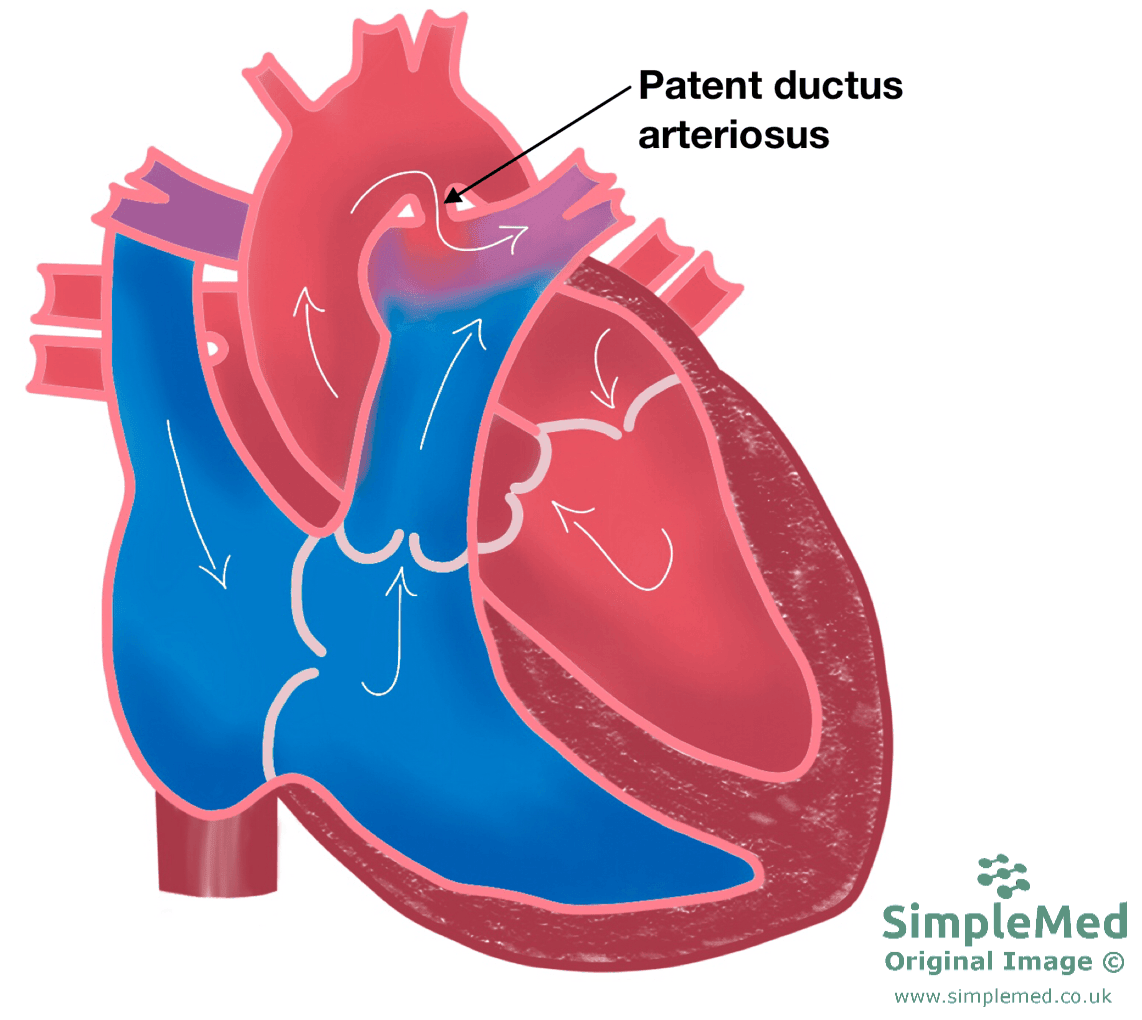
Diagram - A heart with a patent ductus arteriosus heart defect
SimpleMed original by Bethany Turner
- Caused by underdevelopment of the septum primum or secundum, resulting in a hole in the atrial septum.
- This allows blood in the left atrium to flow into the right atrium.
- The increased volume in the right atrium leads to a higher volume of blood being pumped around the pulmonary circulation. If left untreated, this will cause damage to the vasculature and fibrosis of the arteries in the lungs. This makes the arteries less distensible which increases resistance to blood flow and results in pulmonary hypertension.
- Pulmonary hypertension means that the right side of the heart must work against an increased afterload. This increased strain on the heart can lead to right sided heart failure.
- Pulmonary hypertension can cause pulmonary oedema as blood under high pressure forces fluid out of the capillaries into the lungs.
- If the pressure in the pulmonary circulation becomes high enough due t increased resistance, the pressure in the right atrium will exceed that in the left.
- This will cause the flow of blood to reverse, and deoxygenated blood will mix with oxygenated blood in the left atrium. The patient will become cyanotic due to the reduced pO2 in the systemic circulation. This is called Eisenmenger’s syndrome.
- A patent foramen ovale (PFO) is not classed as an ASD. PFO is caused by the failure of the foramen ovale to shut after birth. It is not an ASD because it is a unidirectional shunt (right atrium to left atrium) and there is no defect in the septum of the atria. In adults it generally doesn’t cause symptoms. This is because the pressure in the left ventricle is higher than that in the right, so the shunt does not allow blood to move down this gradient.
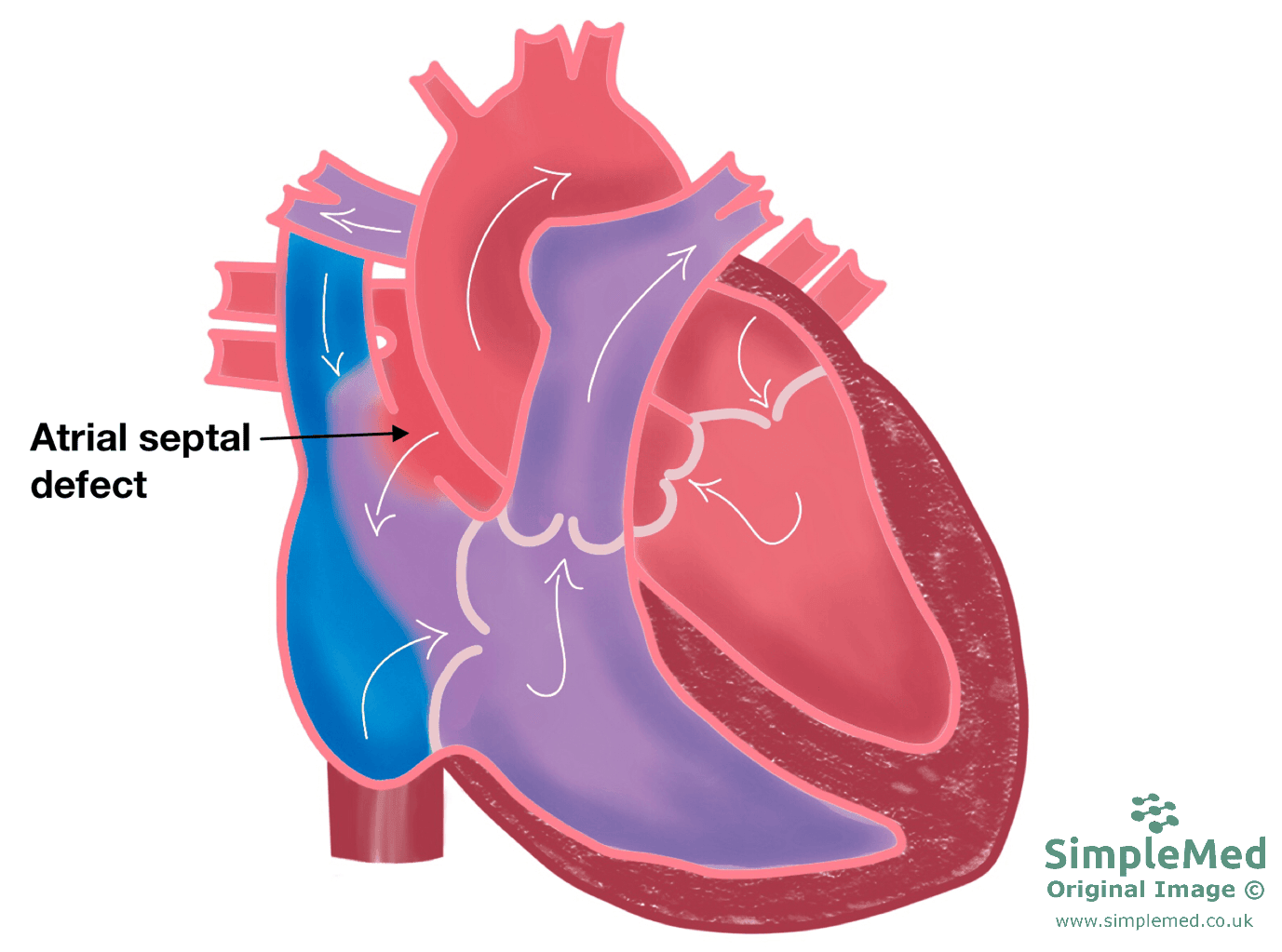
Diagram - A heart with an atrial septal defect
SimpleMed original by Bethany Turner
Ventricular Septal Defect (VSD)
- During development of the interventricular septum, the membranous portion of the septum fails to develop properly. This means that the primary interventricular foramen remains open.
- Blood in the left ventricle will flow into the right ventricle.
- The pressure difference between the ventricles is greater than that between the atria, so there is more blood movement in VSDs than in ASDs.
- By the same mechanism as in ASDs, VSDs if left untreated will cause pulmonary hypertension and eventually right sided heart failure.
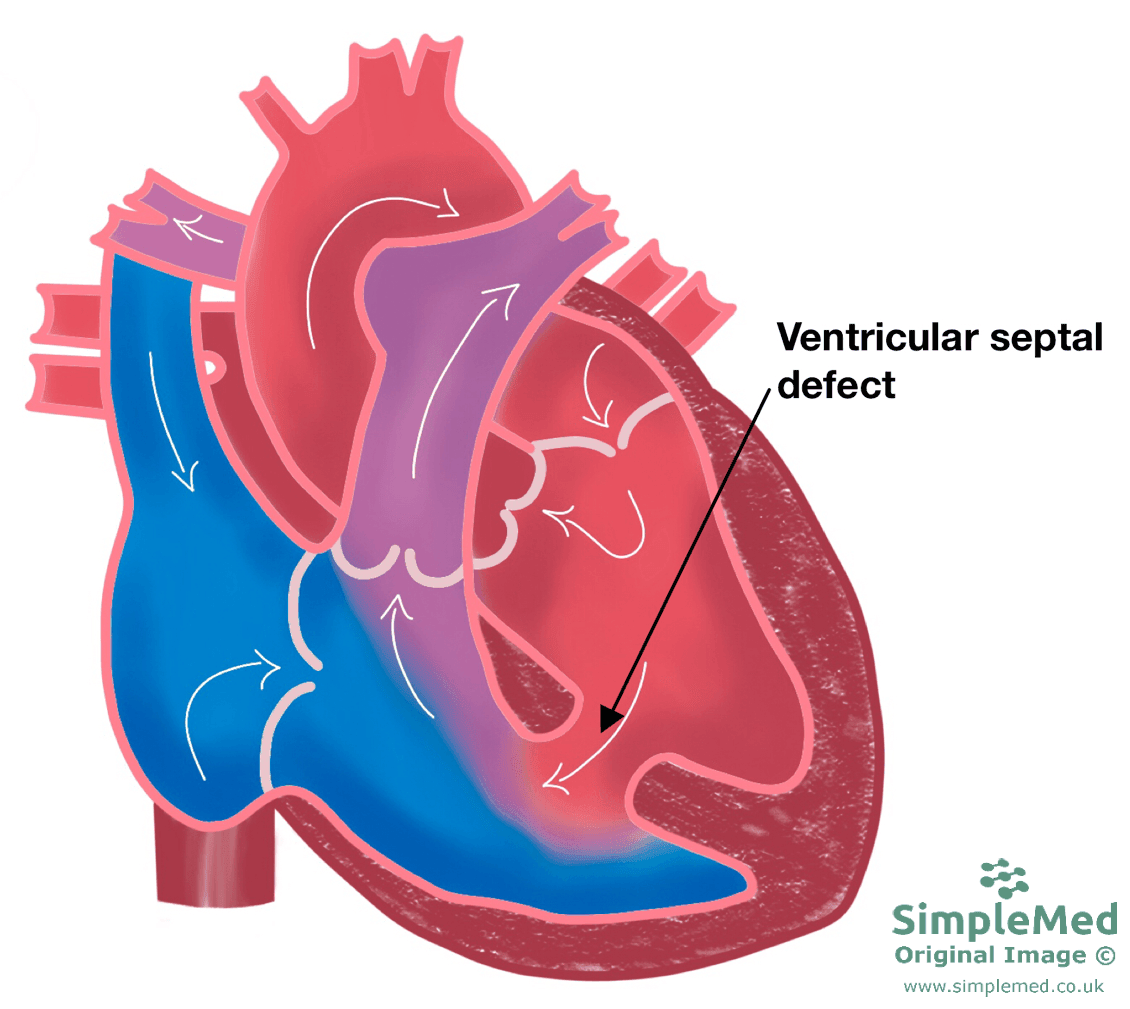
Diagram - A heart with a ventricular septal defect
SimpleMed original by Bethany Turner
Atrioventricular Septal Defect
- Caused by failure of the endocardial cushions to develop properly.
- Results in a hole in the middle of the heart with one common atrioventricular valve, instead of a mitral and a pulmonary valve.
- Common in Down’s syndrome.
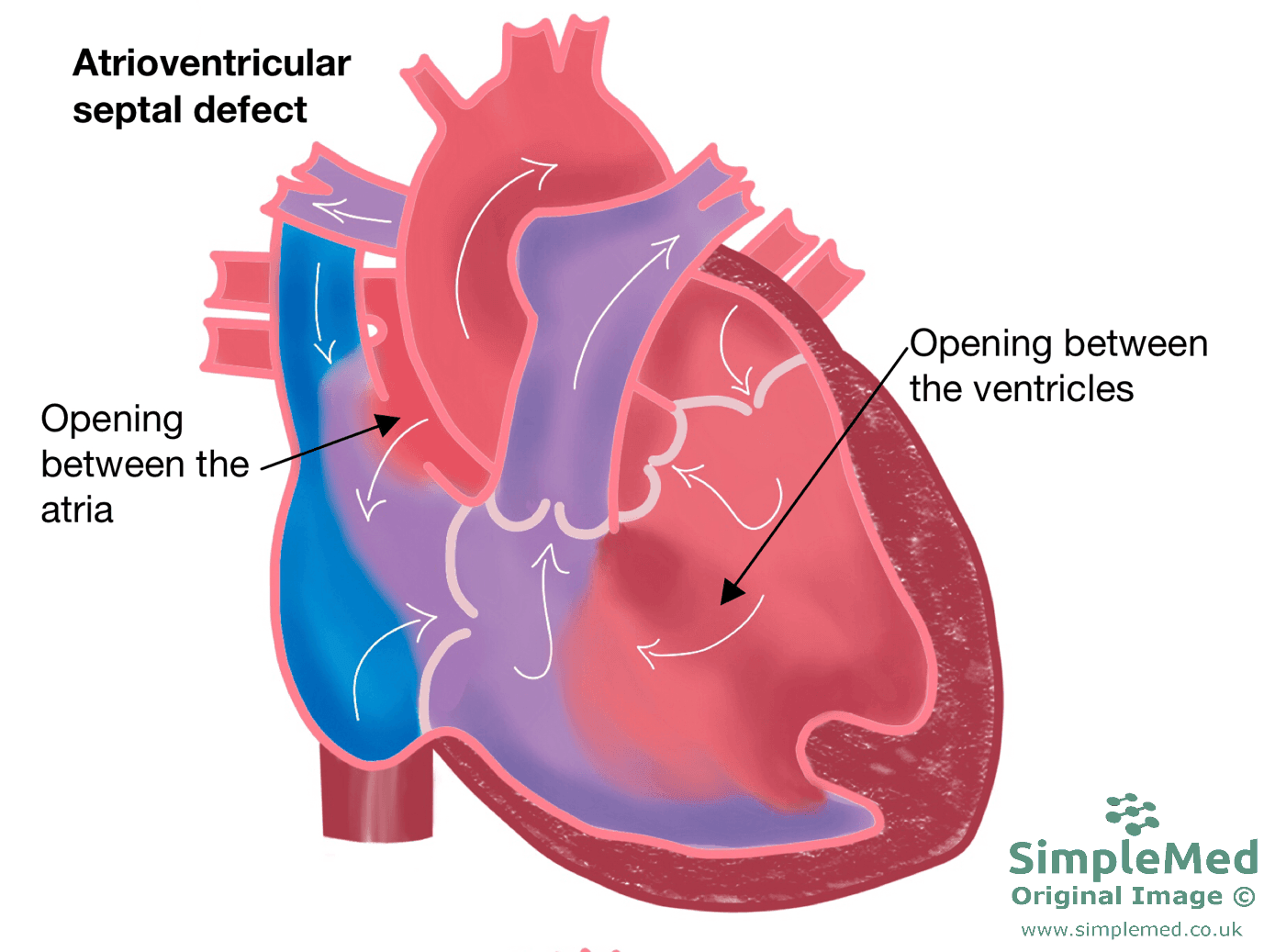
Diagram - A heart with an atrioventricular septal defect
SimpleMed original by Bethany Turner
- One or both semilunar valves don’t develop properly and are narrow when the baby is born.
- In the case of the aortic valve, a common defect is that the valve has only two leaflets.
- This will result in left/right ventricular hypertrophy as the heart is having to generate more force to push blood though the stenosed valve. This hypertrophy can lead to heart failure.
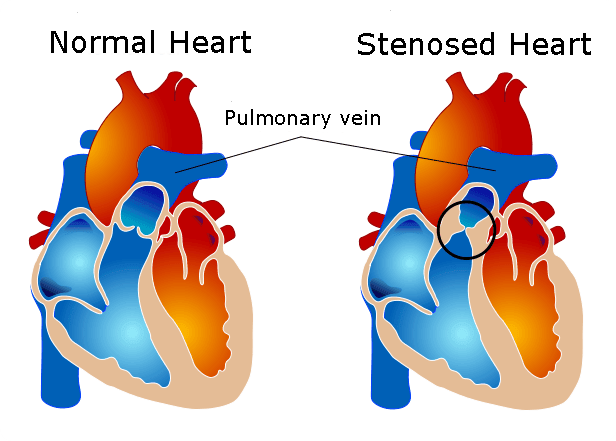
Diagram - A heart with pulmonary stenosis. Notice the narrowed valve at the entrance to the pulmonary vein (circled)
Creative commons source by Mariana Ruiz LadyofHats; derivative work: MrArifnajafov (2010-11-30), translated and edited by Marcus Judge [CC BY-SA 3.0 (https://creativecommons.org/licenses/by-sa/3.0)]
- This is a congenital narrowing of part of the aorta, commonly around the ductus arteriosus area.
- Upstream of the coarctation (towards the heart), blood pressure is high because it struggles to flow past the coarctation. This increases the risk of aneurysms of the aortic arch, and aortic root dilation which can lead to aortic valve regurgitation.
- Downstream of the coarctation (towards the body), patients will have weak pulses and claudication (cramping in the legs in this case due to reduced perfusion).
- If the narrowing is after the three branches of the arch of the aorta, there will be a delay between feeling the radial and femoral pulses – radial-femoral delay.
- If the narrowing is between the brachiocephalic trunk and left subclavian, then there will be a delay between feeling the radial pulses in both wrists – radial-radial delay.
- A patient with coarction of the aorta will present with radio-femoral delay, strong radial pulses, and weak/absent femoral pulses.
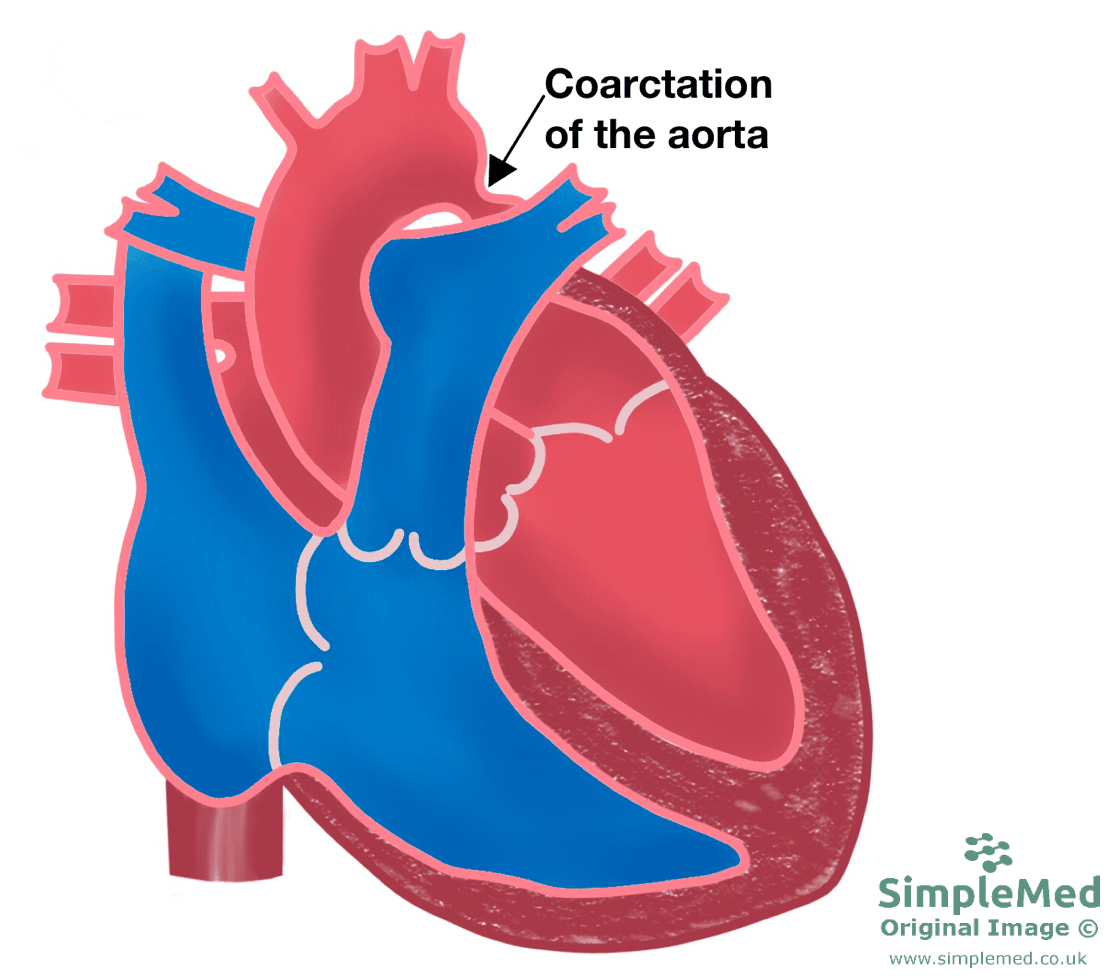
Diagram - A heart with coarctation of the aorta after the braciocephalic artery
SimpleMed original by Bethany Turner
This second section is about the category of cyanotic congenital heart defects. These are a group of heart defects that present with central cyanosis. This is because the blood in the systemic circulation is not saturated with oxygen so the pO2 is low.
- The tricuspid valve fails to form.
- Blood cannot flow from the right atrium to the right ventricle.
- In these babies, there is an ASD and a VSD which allows blood to flow into the pulmonary circulation.
- Deoxygenated blood mixes with oxygenated blood in the left side of the heart as it can only move through the ASD as the valve is fused. This mixing means that blood being pumped into the aorta and to the body will have a low pO2 resulting in central cyanosis.
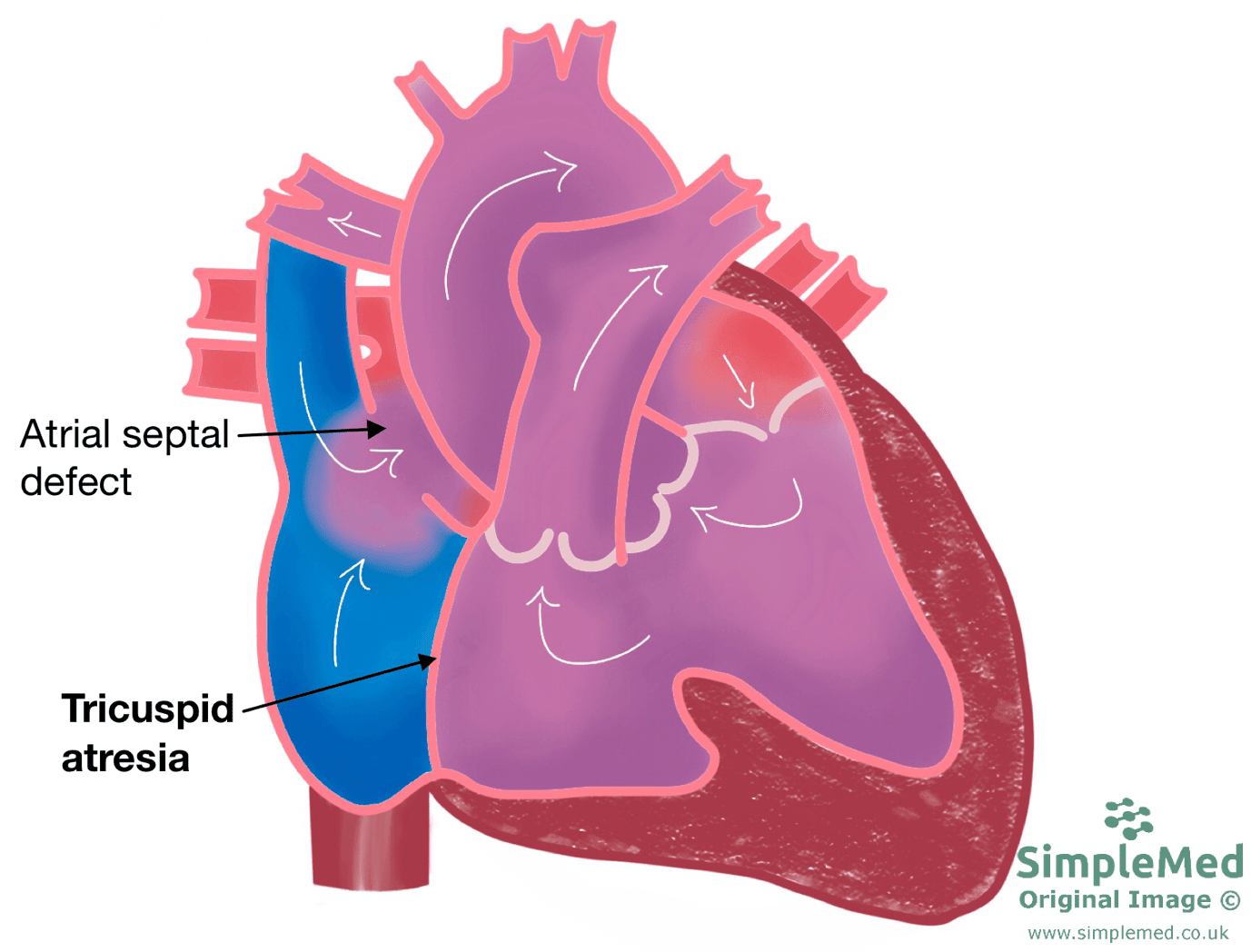
Diagram - A heart with tricuspid atresia
SimpleMed original by Bethany Turner
- The pulmonary valve fails to form. Like tricuspid atresia, the only way that blood can leave the right-hand side of the heart is via a septal defect.
- A ventricular septal defect allows deoxygenated blood to move from the right ventricle to the left ventricle where it mixes with oxygenated blood.
- Newborns can have a patent ductus arteriosus to allow blood into the pulmonary circulation.
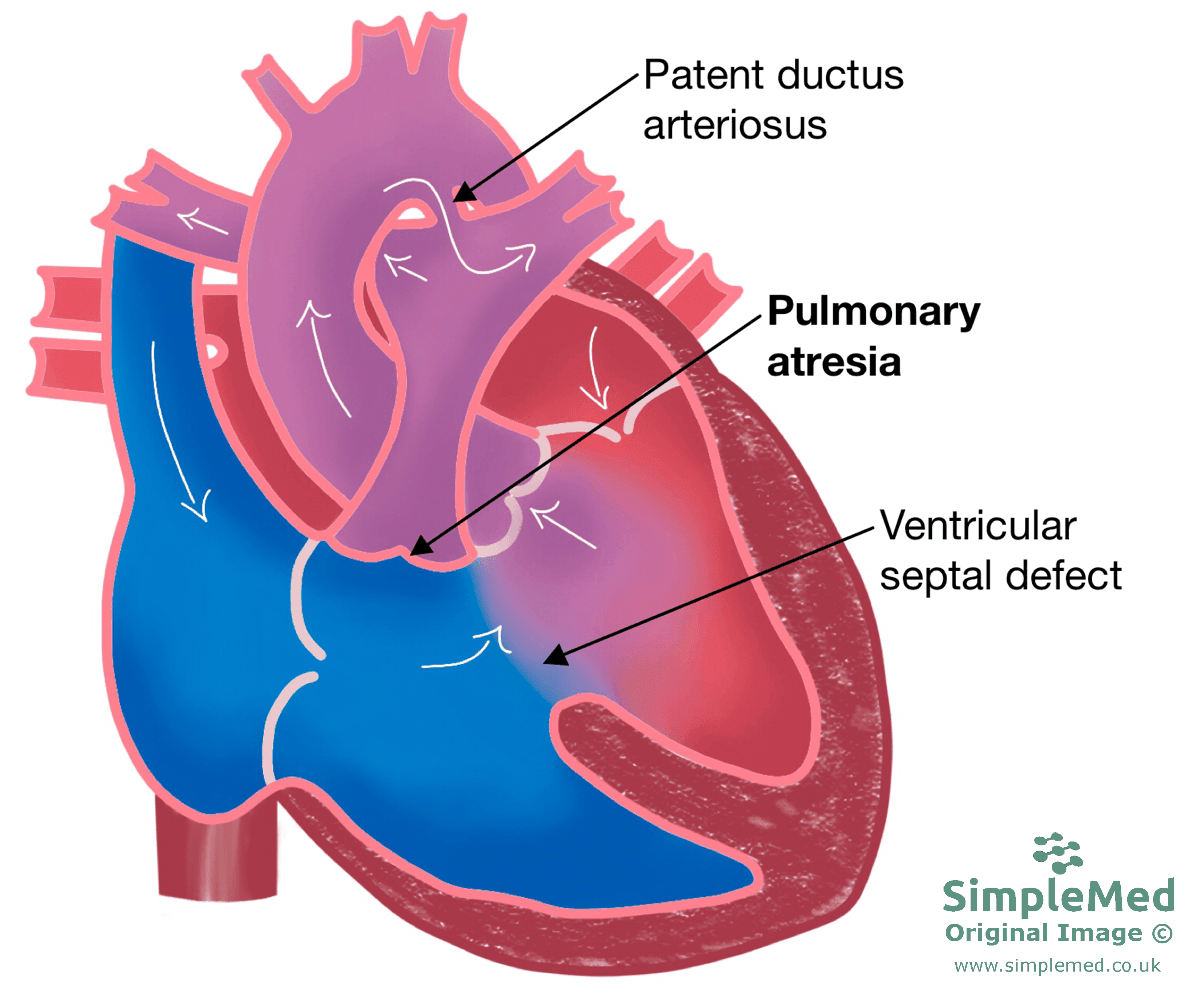
Diagram - A heart with pulmonary atresia. The ventricular septal defect is present to allow blood to flow into the pulmonary circulation in order to maintain life
SimpleMed original by Bethany Turner
Transposition of the Great Arteries
- The aorticopulmonary septum forms, but does not spiral, therefore when the baby is born the aorta arises from the right ventricle, and the pulmonary trunk arises from the left ventricle.
- The pulmonary and systemic circulations are almost separate, with only an ASD and PDA allowing some oxygenated blood to enter the systemic circulation.
- This is a neonatal emergency and prostaglandins must be given to the baby quickly in order to maintain the PDA and allow some oxygenated blood into the systemic circulation until surgery can be performed.
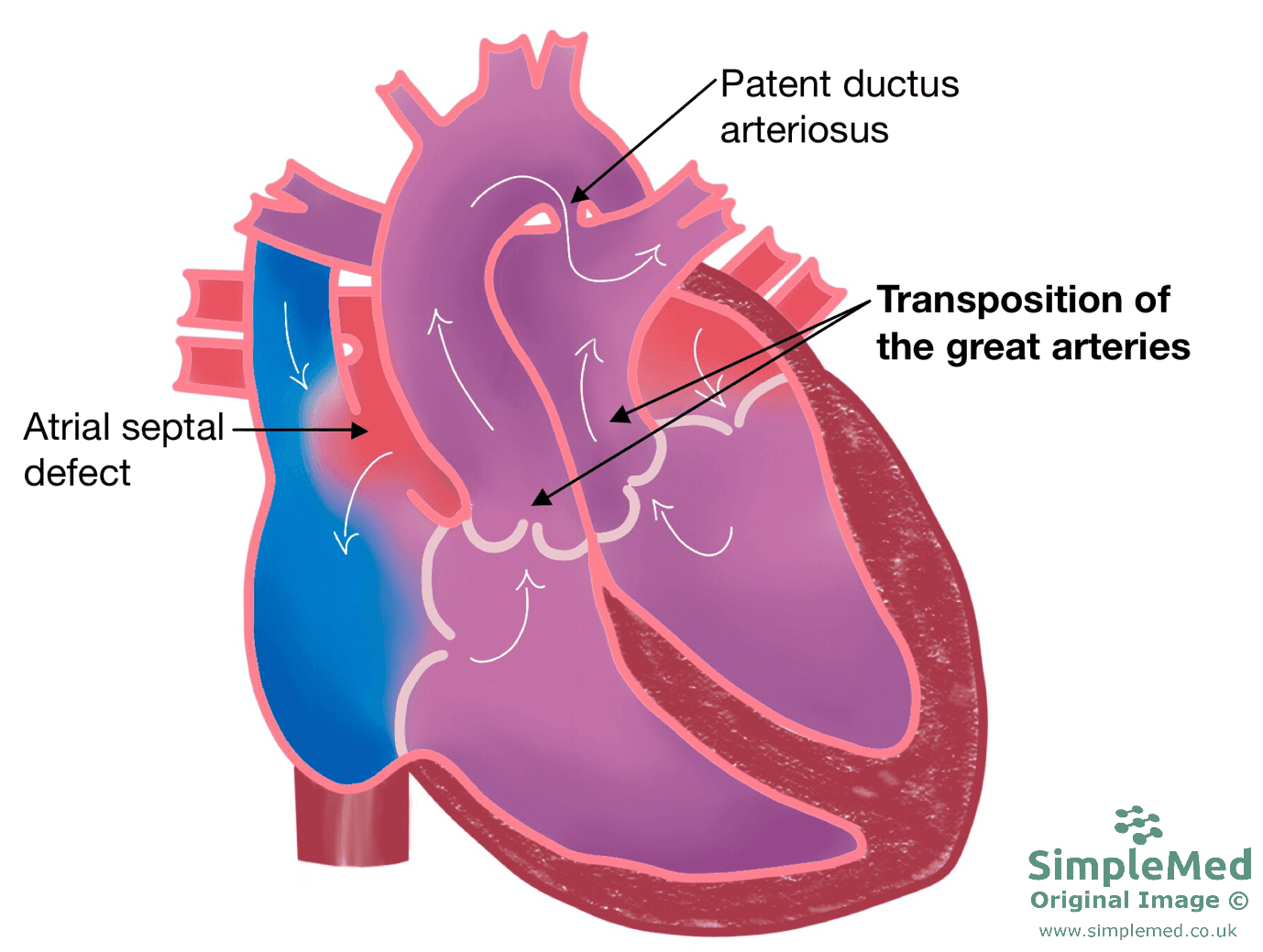
Diagram - A heart with transposition of the great arteries
SimpleMed original by Bethany Turner
- Characterised by four defects that present together:
- Pulmonary Stenosis – the pulmonary artery or the pulmonary valve is narrowed, so less blood can enter.
- Overriding Aorta – aorta is large and situated right next to the VSD so most of the blood in the heart flows through it.
- Ventricular Septal Defect – allows blood from the right ventricle which cannot be pumped through the stenosed pulmonary artery/valve to move into the left ventricle and be pumped around the body via the aorta.
- Hypertrophy of the Right Ventricle – in an attempt to generate more force to pump the blood through the stenosis into the pulmonary artery.
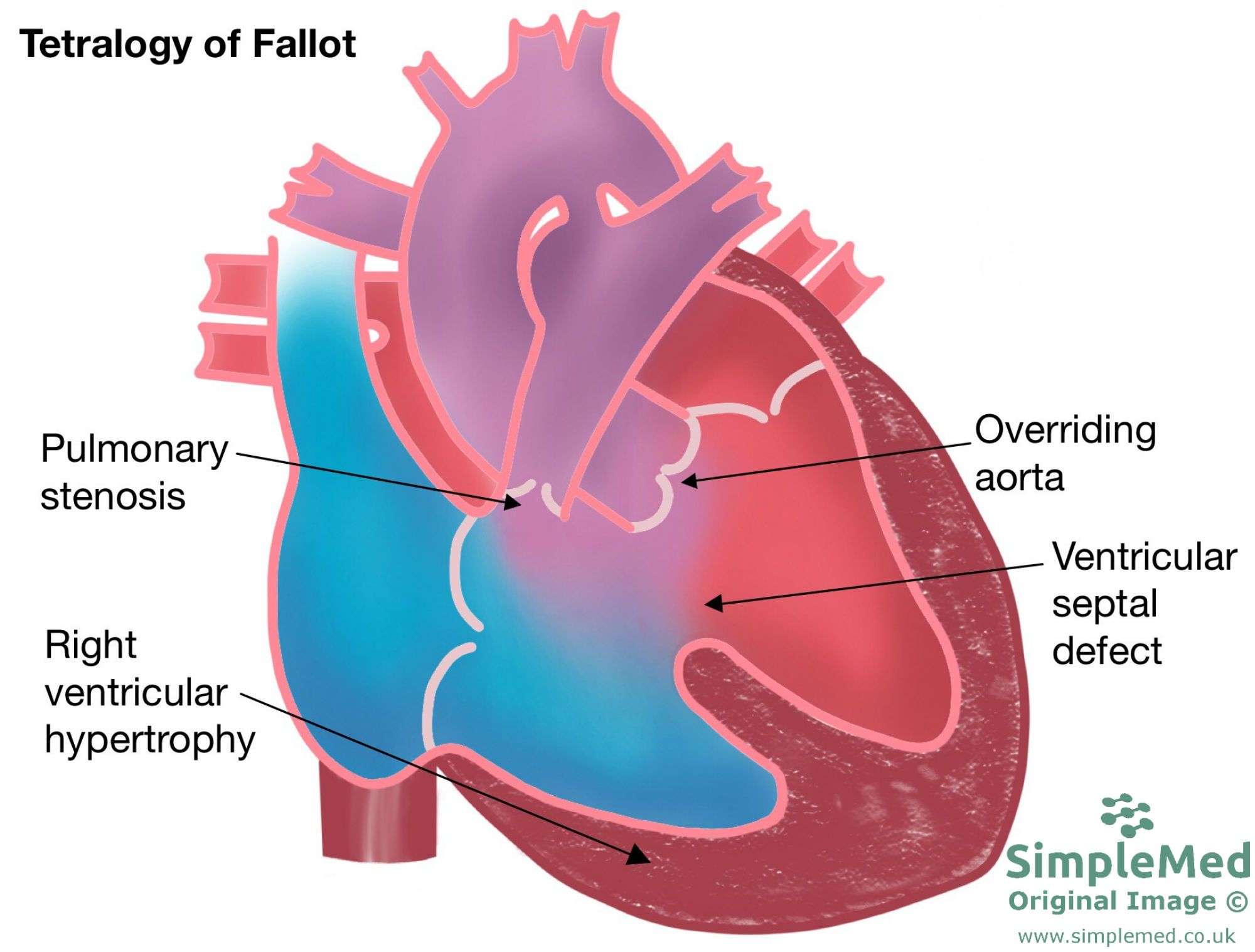
Diagram - A heart with all the components of Tetralogy of Fallot
SimpleMed original by Bethany Turner
- Mitral or aortic valves are stenosed in utero which means that less blood flows into the left ventricle. This results in the left ventricle being underdeveloped.
- An ASD allows blood to flow into the right side of the heart and be pumped into the pulmonary artery, and a PDA allows this blood to enter the aorta from the left pulmonary artery.
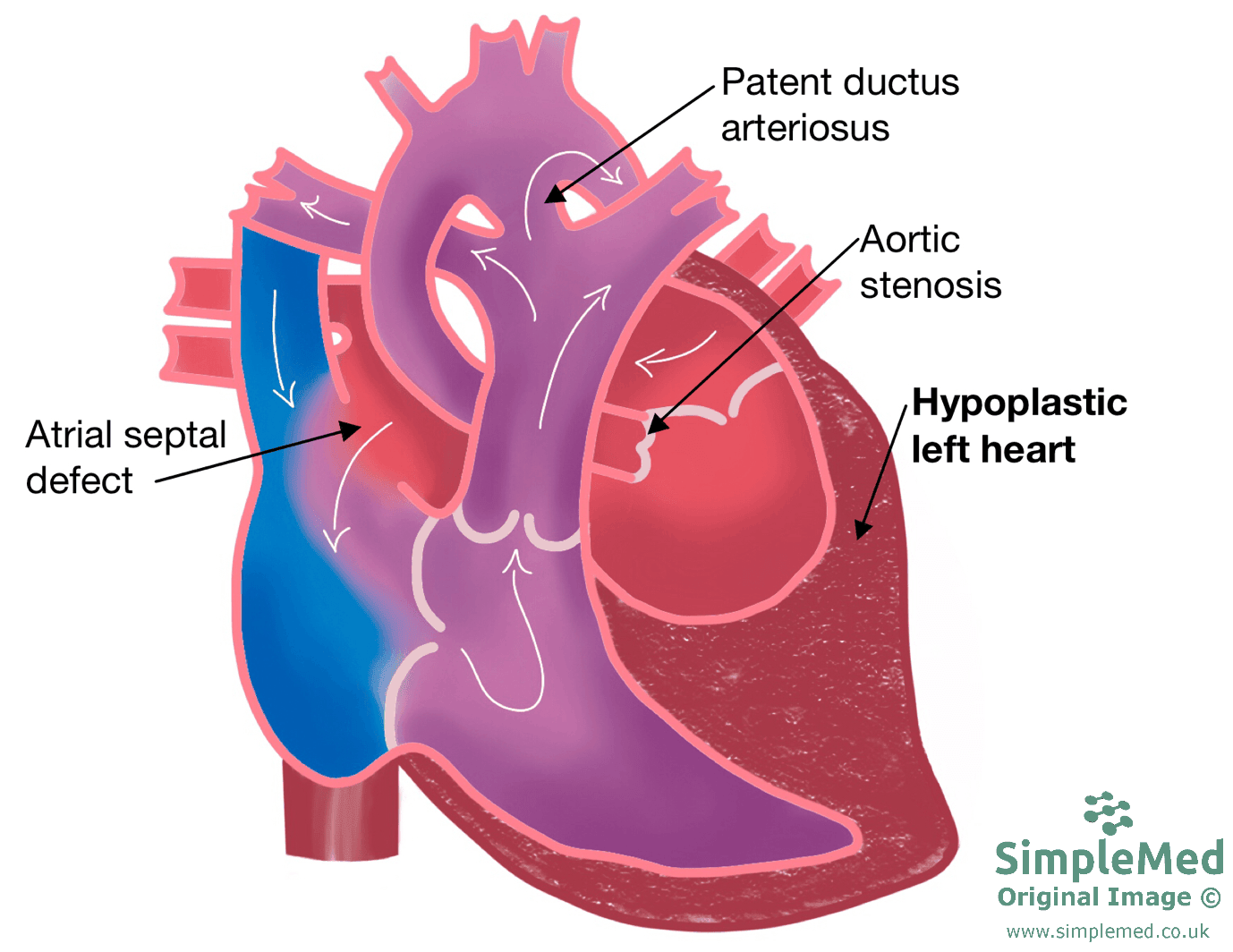
Diagram - A hypoplastic left heart
SimpleMed original by Bethany Turner
- The ventricular septum doesn’t form, so oxygenated and deoxygenated blood mixes in the ventricle, and gets pumped into both the aorta and pulmonary trunk.
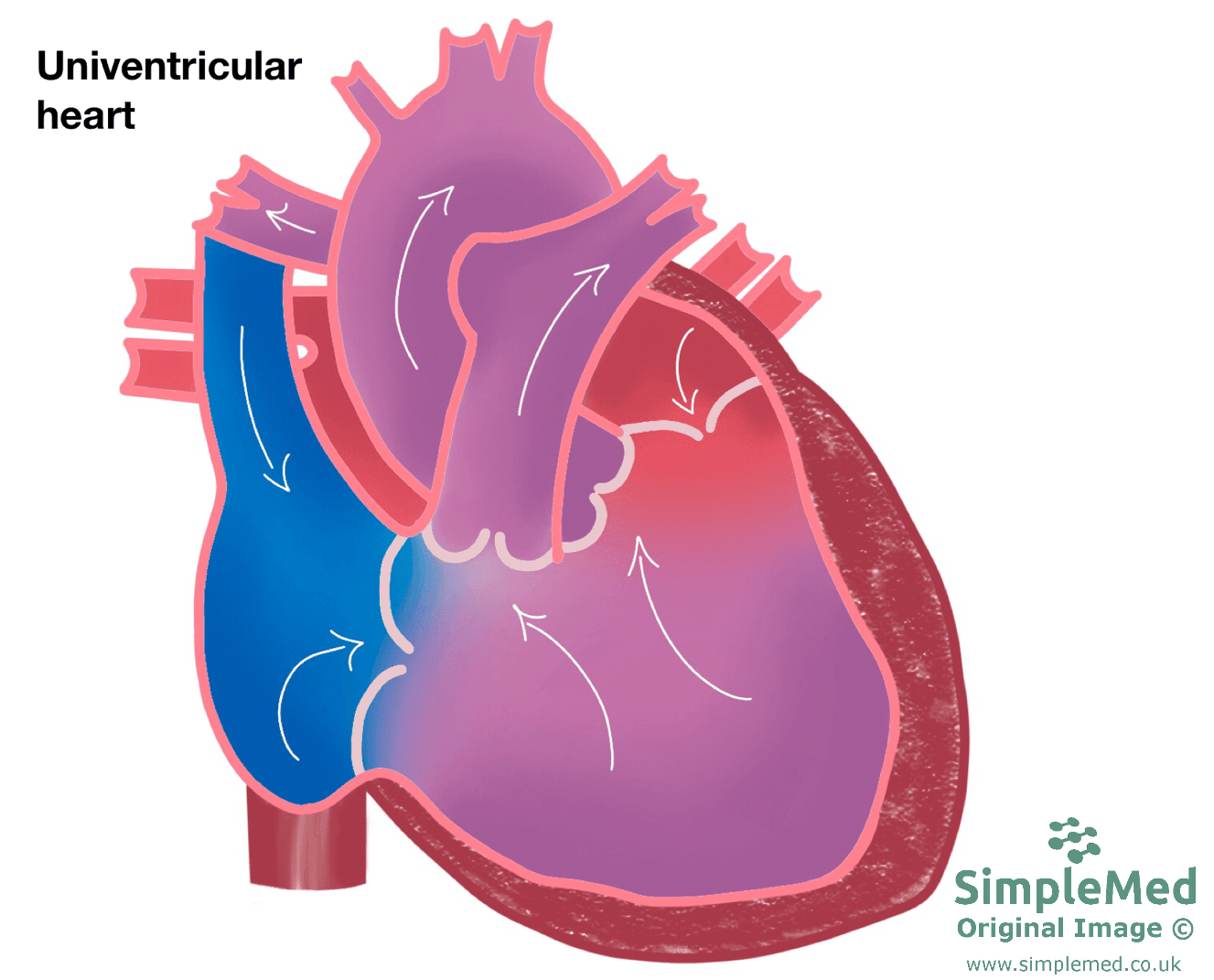
Diagram - A heart with one ventricle
SimpleMed original by Bethany Turner
Edited by: Dr. Ben Appleby
- 14842

